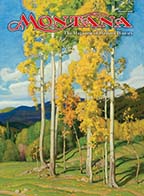RESOURCES & RESEARCH
The Identifying Montana’s African American Heritage Places Project worked with a team of historians, researchers, and volunteers to compile the resources that informed the history contained within this website. It is a goal of this project to share those same resources for public use. Whether you are a professional historian, college student, teacher, or just looking to learn more about Montana’s African American past, we hope you will find these sources helpful and enlightening.

The Oral History page provides information regarding oral interviews conducted for this project, including digital audio files. It also includes links to audio files of interviews conducted through Washington State University in the early 1970s, and a selected annotated list of oral history interviews housed at the Montana Historical Society Research Center Archives.
The MHS Collections page contains an illustrated and annotated table of museum artifacts, photographs, manuscript collections, and oral histories related to African American History housed at the Montana Historical Society.
All three of Montana’s historic African American newspapers can be found in digitized, searchable format on the Library of Congress’ Chronicling America website.
The Colored Citizen (Helena 1894)
The New Age (Butte, 1902-1903)
The Montana Plaindealer (Helena 1906-1911)
Montana legislation passed between 1864 and 2003 intended to either discriminate against or to protect the rights of the African American community. Based on Glenda Rose Spearman Eruteya’s “Racial Legislation in Montana: 1864 – 1955.”
List of black soldiers stationed at Ft. Harrison, Helena, 1903.

Also see our collection of Montana census information (1910 and 1930) for several communities. Links to spreadsheets can be found in the sidebar.
Montana: Race and Hispanic Origin, 1870-1990 (PDF)
Additional census information:
African American Populations and Surrounding States (PDF)
African-American Montanans (PDF) (Excel)
1870 Census - (PDF) (Excel)
1910 Census - (PDF) (Excel)
1930 Census - (PDF) (Excel)
For researchers who are interested in specific demographic trends, database queries retrieving birthplace, age, sex, residence county and city, and occupations were also exported to Excel worksheets which, again, can be downloaded "as is" or imported into a database.
Comprehensive Census Data Queries (Excel)
1870 Birthplace/Age/Sex/Residence - (PDF)
1870 Occupations over age 12 - (PDF)
1910 Birthplace/Age/Sex/Residence - (PDF)
1910 Occupations over age 11 - (PDF)
1930 Birthplace/Age/Sex/Residence - (PDF)
1930 Occupations over age 14 - (PDF)
Fifty-one historic property record forms compiled for this project describe and provide brief histories of Montana places associated with the state’s African American history. They can be found on the Montana History Portal and on this website’s Places page.
The Places page also contains links to the National Register of Historic Places nominations forms for those Montana properties listed for their association with African American history, as well as the “African-American Heritage Places in Helena, MT” Multiple Properties Documentation form by Delia Hagen, which includes a comprehensive historic context of the African American experience in that city and statewide.

Over the years, Montana The Magazine of Western History [Helena, MT: Montana Historical Society Press, 1951-present] has published several articles relating to the African American experience throughout the West. These include:
Castles, Jean I. “The West: Crucible of the Negro.” Montana The Magazine of Western History. Vol. 19, No. 1 (1969), pp. 83–84.
Chaffin, Glenn. “Aunt Tish: Beloved Gourmet of the Bitter Root.” Montana The Magazine of Western History. Vol. 21, No. 4 (1971): 67–69.
Davison, Stanley R, and Dale Tash. “Confederate Backwash in Montana Territory.” Montana The Magazine of Western History. Vol. 17, No. 4 (1967), pp. 50–58.
Erickson, Christine K. “‘Kluxer Blues’: The Klan Confronts Catholics in Butte, Montana, 1923-1929.” Helena, MT: Montana The Magazine of Western History. Vol. 53, No. 1 (Spring 2003), pp. 44-57.
Meredith, Scott. “Identifying African American Resources Project.” Helena, MT: Montana The Magazine of Western History. Vol. 57, No. 1 (Spring, 2007), pp. 61-66+96.
Riley, Glenda. “American Daughters: Black Women in the West.” Montana The Magazine of Western History. Vol. 38, No. 2 (1988): 14–27.
Another valuable essay published by the Montana Historical Society is: Smurr, J.W. “Jim Crow Out West.” In J.W. Smurr and K. Ross Toole, eds. Historical Essays on Montana and the Northwest. Helena, MT: The Western Press, Historical Society of Montana, 1957, pp. 149-203
The Montana Historical Society’s Women’s History Matters website contains several essays about the black experience in Montana:
“Celebrating Sarah Gammon Bickford.” Women’s History Matters, August 14, 2014. http://montanawomenshistory.org/celebrating-sarah-gammon-bickford/.
“‘Lifting as We Climb’: The Activism of the Montana Federation of Colored Women’s Clubs.” Women’s History Matters, July 1, 2014. http://montanawomenshistory.org/lifting-as-we-climb-the-activism-of-the-montana-federation-of-colored-womens-clubs/.
“Mary Fields.” Women’s History Matters, 2014. http://montanawomenshistory.org/tag/mary-fields/.
“Montana Women of the Ku Klux Klan.” Women’s History Matters, August 7, 2014. http://montanawomenshistory.org/montana-women-of-the-ku-klux-klan/.
“Two Legendary African American Homesteaders.” Women’s History Matters, October 7, 2014. http://montanawomenshistory.org/two-legendary-african-american-homesteaders/.
In addition, see our Selected Bibliography of Books, Articles, and Websites Associated with the African American Experience in Montana and the U.S. West. Many articles listed are available with a JSTOR subscription or through various libraries state wide.
This material is based upon work assisted by grants from the Department of the Interior, National Park Service and the Montana History Foundation. Any opinions, findings, and conclusions or recommendations expressed in this material are those of the author(s) and do not necessarily reflect the views of the Department of the Interior nor the Montana History Foundation.
